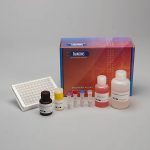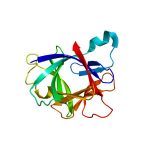
Salimetrics Assay #1-3902
The Salimetrics Salivary IL-1 Beta (IL-1B, Interleukin-1 beta, IL-1β) Enzyme Immunoassay Kit was specifically designed to standardize the detection of IL-1 Beta in saliva samples for research and biomedical laboratories. Using a small sample volume, this assay kit has an extended range that spans the expected IL-1 Beta levels found in human saliva. The average inter- and intra-assay precision coefficients of variation are low with no deleterious matrix effects often found in saliva which are characterized through dilution- and spike-recovery validation procedures. This IL-1 Beta assay kit has also been formatted to minimize cross reactivity for related cytokines.Interleukin-1 Beta is widely accepted as a biomarker of systemic inflammation. IL-1 Beta serves an important role in activating the production of other pro-inflammatory cytokines such as TNF-α, IL-6, and IL-1α, as well as inducing the acute phase response. IL-1 Beta is considered the prototypic ‘multi-functional’ cytokine, affecting nearly all cell types, either alone, or in combination with other cytokines. IL-1β and its associated signaling systems may also play a role in mediating the response of the circadian timing system to immune challenge, as well as the basal functioning of the SCN clock. IL-1 Beta is present in the saliva of both healthy and diseased individuals. The sources of IL-1 Beta production in the oral cavity include macrophages, monocytes, fibroblasts, and mucosal epithelial cells. IL-1 Beta has also been found to be synthesized and released from acinar and ductal cells in mouse salivary glands. Human tear fluid and gingival crevicular fluid (GCF), which may be present as components of whole saliva, also contain IL-1β. Read More...Levels of IL-1 Beta in saliva and CGF have been studied in relation to gingival and periodontal disease, as well as in relation to other oral diseases such as Sjögren’s syndrome and oral cancer. Levels of IL-1 Beta in saliva and GCF have also been observed to change in response to various types of physical and psychological stressors, similar to the response seen in the circulation. Additionally, IL-1 Beta levels in saliva and GCF have been reported to have a circadian rhythm. Dysregulation of IL-1 Beta synthesis or control mechanisms can be involved in numerous disease processes. Studies in humans report that IL-1 Beta levels are generally higher in saliva than in plasma or serum, and serum/plasma levels are often below the limit of detection. Correlation of IL-1 Beta levels in blood and saliva has not been reported in humans, but blood-saliva correlations for other pro-inflammatory cytokines, such as IL-6, have generally been found to be only modest. IL-1 Beta has also been found to be released from mouse parotid acinar cells in response to alpha- and beta-adrenergic stimulation.
Technical Summary
| Assay Protocol |
|---|
| Rev. 04.19.19
|
| Specifications | |
|---|---|
| Catalog#: | 1-3902 |
| Regulatory Status: | RUO |
| Format: | 96-well plate |
| Assay Time: | ~ 4.5 hrs |
| Sample Volume/Test: | 20 µL |
| Sensitivity: | <0.37 pg/mL |
| Assay Range: | 3.13 pg/mL – 200 pg/mL |
| Storage Requirements: | 2-8°C |
| Tests Per Kit | |
|---|---|
| Singlet: | 76 |
| Duplicate: | 38 |
| Target Analyte |
|---|
| Technical Documentation |
|---|
Salivary IL-1 Beta Assay Kit Overview
Intended Use
The Salimetrics IL-1 Beta ELISA kit is a sandwich immunoassay specifically designed and validated for the quantitative measurement of salivary IL-1β. It is not intended for diagnostic use. This assay kit was designed and optimized for salivary research use in humans. Salimetrics has not validated this kit for serum, plasma or saliva samples from any other species.
Introduction
Interleukin-1β (IL1B) is a key pro-inflammatory cytokine that is released after infection, injury, or antigenic challenge. It has been widely studied for its role as a multi-functional signaling molecule that affects nearly all cell types, either alone or in combination with other pro-inflammatory cytokines. Circulating IL1B is principally produced by activated macrophages, but it is also secreted from a wide variety of epidermal, epithelial, lymphoid, and vascular tissues. IL1B is also present in the saliva of both healthy and diseased individuals. In the oral cavity, the sources of IL1B production include macrophages, monocytes, fibroblasts, and mucosal epithelial cells. IL1B has also been reported to be synthesized and released from acinar and ductal cells in mouse salivary glands. Human tear fluid and gingival crevicular fluid (GCF), which may be present as components of whole saliva, also contain IL1B. Salivary IL1B has been reported to have a circadian rhythm with highest levels in the morning (after waking) and lowest levels in the evening. This is the opposite of the pattern seen in serum, where peak levels occur from 1-4 AM and daytime levels are low. Levels of IL1B in saliva and GCF have been studied in relation to gingival and periodontal disease, and significant correlation to the presence of periodontal disease has been found. Levels of IL1B in saliva and GCF have been observed to change in response to various types of physical and psychological stressors, similar to the response seen in circulation. The relationship between salivary and circulating levels of IL1B is not clear. Serum or plasma levels of IL1B in healthy individuals are very low and often below the limit of detection. IL1B levels are generally higher in saliva than in plasma or serum. One study has reported that the correlation between human passive drool saliva samples and plasma for IL1B is not statistically significant.
Salivary IL-1 Beta Assay Principle
This is a sandwich ELISA kit. IL-1 Beta in standards and samples binds to the antibody binding sites on a microtitre plate. After incubation, unbound components are washed away. Biotin conjugated to goat antibodies to human IL-1 Beta are added and attach to the bound IL-1 Beta. After incubation, unbound components are washed away. Streptavidin conjugated to horseradish peroxidase (HRP) is added and binds to the biotin conjugated to the goat antibodies. Bound Streptavidin-HRP is measured by the reaction of the horseradish peroxidase enzyme to the substrate tetramethylbenzidine (TMB). This reaction produces a blue color. A yellow color is formed after stopping the reaction with an acidic solution. The optical density is read on a standard plate reader at 450 nm. The amount of Streptavidin-HRP detected is proportional to the amount of IL-1 Beta present in the sample.
References & Salivary IL-1 Beta Research
- Giannobile, W.V., Beikler, T., Kinney, J.S., et al. (2009). Saliva as a diagnostic tool for periodontal disease: Current state and future directions. Periodontology 2000, 50, 52-64.
- Pirhonen, J., Sareneva, R., Kurimoto, M., et al. (1999). Virus infection activates IL-1β and IL-18 production in human macrophages by a caspase-1-dependent pathway. J Immunol, 162(12), 7322-29.
- Park, D.R., Thomsen, A.R., Frevert, C.W. et al. (2003). Fas (CD95) induces proinflammatory cytokine responses by human monocytes and monocyte-derived macrophages. J Immunol, 170(12), 6209-16.
- Hernández-Rodríguez, J., Segarra, M., Vilardell, C., et al. (2004). Tissue production of pro-inflammatory cytokines (IL-1β, TNFα, and IL-6) correlates with the intensity of the systemic inflammatory response and with corticosteroid requirements in giant-cell arteritis. Rheumatology (Oxf.), 43(3), 294-301.
- Southerland, J.H., Taylor, G.W., Moss, K., et al. (2006). Commonality in chronic inflammatory diseases: Periodontitis, diabetes, and coronary artery disease. Periodontology 2000, 40, 130-43.
- Tzouvelekis, A., Pneumatikos, I, Bouros, D. (2005). Serum biomarkers in acute respiratory distress syndrome an ailing prognosticator. Respir Res, 6, 62.
- Miller, C.S., King C.P., Langub, M.C., et al. (2006). Salivary biomarkers of existing periodontal disease: A cross-sectional study. J Am Dent Assoc, 137(3), 322-29.
- Tanda, N., Ohyama, H., Yamakawa, M., et al. (1998). IL-1β and IL-6 in mouse parotid acinar cells: Characterization of synthesis, storage, and release. Am J Physiol, 274(1 Pt1), G147-56.
 Contact: Salimetrics (USA)
Contact: Salimetrics (USA)
